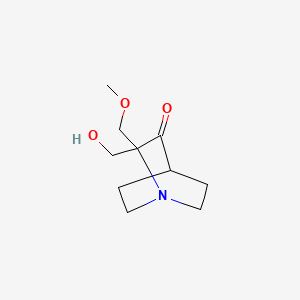Ferroptosis-centered Drug Response Information
General Information of the Drug (ID: ferrodrug0302)
| Name |
APR-246
|
||||
|---|---|---|---|---|---|
| Synonyms |
APR-246; 5291-32-7; PRIMA-1MET; Eprenetapopt; 2-(Hydroxymethyl)-2-(methoxymethyl)-1-azabicyclo[2.2.2]octan-3-one; 2-(Hydroxymethyl)-2-(methoxymethyl)quinuclidin-3-one; APR 246; Eprenetapopt [USAN]; Z41TGB4080; 3-Quinuclidinone, 2-(hydroxymethyl)-2-(methoxymethyl)-; 1-Azabicyclo(2.2.2)octan-3-one, 2-(hydroxymethyl)-2-(methoxymethyl)-; Prima 1MET; UNII-Z41TGB4080; EPRENETAPOPT [INN]; MLS006010767; EPRENETAPOPT [WHO-DD]; APR246; SCHEMBL2228161; CHEMBL3186011; SCHEMBL21636035; PRIMA-1MET(APR-246); APR-246 (PRIMA-1MET); DTXSID401164013; BCP20294; EX-A2772; MFCD20620963; NSC791496; s7724; WHO 11387; AKOS024457764; CCG-266578; CS-7614; DB11684; NSC-791496; SB19737; NCGC00346881-01; AC-32964; AS-72033; BA176962; HY-19980; SMR004701457; A901731; Q27294965; 2-hydroxymethyl-2-methoxymethyl-1-azabicyclo[2.2.2]octan-3-one
Click to Show/Hide
|
||||
| Structure |
 |
||||
| Formula |
C10H17NO3
|
||||
| IUPAC Name |
2-(hydroxymethyl)-2-(methoxymethyl)-1-azabicyclo[2.2.2]octan-3-one
|
||||
| Canonical SMILES |
COCC1(C(=O)C2CCN1CC2)CO
|
||||
| InChI |
InChI=1S/C10H17NO3/c1-14-7-10(6-12)9(13)8-2-4-11(10)5-3-8/h8,12H,2-7H2,1H3
|
||||
| InChIKey |
BGBNULCRKBVAKL-UHFFFAOYSA-N
|
||||
| PubChem CID | |||||
Full List of Ferroptosis Target Related to This Drug
Unspecific Target
| In total 1 item(s) under this Target | |||||
| Experiment 1 Reporting the Ferroptosis-centered Drug Act on This Target | [1] | ||||
| Responsed Disease | Oesophageal cancer | ICD-11: 2B70 | |||
| Responsed Regulator | Cysteine desulfurase (NFS1) | Driver | |||
| Pathway Response | Glutathione metabolism | hsa00480 | |||
| Ferroptosis | hsa04216 | ||||
| Cell Process | Cell ferroptosis | ||||
| Cell proliferation | |||||
| In Vitro Model | NCI-H1299 cells | Lung large cell carcinoma | Homo sapiens | CVCL_0060 | |
| OACM5.1 C cells | Esophageal adenocarcinoma | Homo sapiens | CVCL_1842 | ||
| FLO-1 cells | Barrett adenocarcinoma | Homo sapiens | CVCL_2045 | ||
| HEK-293T cells | Normal | Homo sapiens | CVCL_0063 | ||
| In Vivo Model |
For FLO-1 LM cell line xenografts, 5 x 106 cells suspended in 100 ul of 1:1 PBS and Matrigel (BD Biosciences) were subcutaneously injected into the right flank of ~6 week-old female nonobese diabeticsevere combined immunodeficient interleukin-2RKO (NSG) mice. PDXs were established and implanted into a dorsal intramuscular pocket of NSG mice as previously described. Mice were randomized to SG deplete or control chow ad libitum (AIN93G rodent diet, Specialty Feeds, Australia) and dosed with eprenetapopt (100 mg/kg) or 0.9% saline, intraperitoneally injected daily, once tumors reached 100 mm3. Tumor volume was assessed blinded to treatment group with caliper measurements every 3 to 4 days and calculated using the formula (length x weight2)/2. Metastatic spread was determined by bioluminescence imaging as previously described involving weekly monitoring using the Xenogen IVIS 100 Imaging System (Caliper Life Science). At experimental end point (tumor volume > 1400 mm3), the whole mouse and its organs were imaged to determine the extent and distribution of metastases. Tumors were weighed and tumor growth inhibition was calculated with the formula [1 - (Tf- Ti)/mean(Cf - Ci)] x 100, where Tf, Ti, Cf, and Ci represent final (f) and initial (i) tumor volume of drug treated (T) and control (C) animals, respectively.
Click to Show/Hide
|
||||
| Response regulation | The study demonstrates that eprenetapopt targets cancer cells through GSH depletion and inhibiting cysteine desulfurase activity of NFS1, leading to iron-dependent, nonapoptotic ferroptosis. The combination of eprenetapopt with dietary serine and glycine restriction synergizes to inhibit esophageal xenograft tumor growth. | ||||
Phospholipid hydroperoxide glutathione peroxidase (GPX4)
| In total 1 item(s) under this Target | |||||
| Experiment 1 Reporting the Ferroptosis-centered Drug Act on This Target | [2] | ||||
| Target for Ferroptosis | Suppressor | ||||
| Responsed Disease | Acute myeloid leukaemia | ICD-11: 2A60 | |||
| Pathway Response | Fatty acid metabolism | hsa01212 | |||
| Ferroptosis | hsa04216 | ||||
| Glutathione metabolism | hsa00480 | ||||
| Cell Process | Cell ferroptosis | ||||
| In Vitro Model | HL-60 cells | Adult acute myeloid leukemia | Homo sapiens | CVCL_0002 | |
| MOLM-14 cells | Leukemia | Homo sapiens | CVCL_7916 | ||
| SET-2 cells | Acute megakaryoblastic leukemia | Homo sapiens | CVCL_2187 | ||
| MV4-11 cells | Childhood acute monocytic leukemia | Homo sapiens | CVCL_0064 | ||
| OCI-AML-2 cells | Acute myeloid leukemia | Homo sapiens | CVCL_1619 | ||
| OCI-AML3 cells | Adult acute myeloid leukemia | Homo sapiens | CVCL_1844 | ||
| K-562 cells | Chronic myelogenous leukemia | Homo sapiens | CVCL_0004 | ||
| THP-1 cells | Childhood acute monocytic leukemia | Homo sapiens | CVCL_0006 | ||
| UT-7/Epo cells | Acute megakaryoblastic leukemia | Homo sapiens | CVCL_5202 | ||
| SKM-1 cells | Acute myeloid leukemia | Homo sapiens | CVCL_0098 | ||
| NB4 cells | Acute promyelocytic leukemia | Homo sapiens | CVCL_0005 | ||
| Kasumi-1 cells | Acute myeloid leukemia | Homo sapiens | CVCL_0589 | ||
| In Vivo Model |
Xenograft tumors were generated by randomly injecting 1 x 106 MOLM14 shCTRL or shSLC7A11 cells into the tail veins of NOD/SCID IL-2 receptor g-chain-null mice (NSG) aged 6-9 weeks. Fourteen days after injection, doxycycline (200 mg/mL) and sucrose (1% weight:volume) were added to the drinking water of these animals. After 3 days, the mice were randomly treated with a daily intraperitoneal injection of APR-246 (100 mg/kg) or vehicle (phosphate-buffered saline [PBS]) for 4 days.
Click to Show/Hide
|
||||
| Response regulation | APR-246 is a promising new therapeutic agent that targets p53 mutated proteins in myelodysplastic syndromes and in acute myeloid leukemia (AML). The association of APR-246 with induction of ferroptosis (either by pharmacological compounds, or genetic inactivation of SLC7A11 or GPX4) had a synergistic effect on the promotion of cell death, both in vivo and ex vivo. | ||||
References
